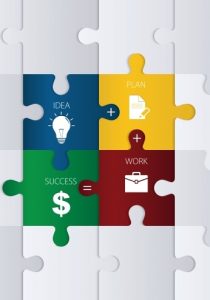“There is a strong correlation between the value of a patent and the likelihood that the technology it describes is instantiated in real-world commercial products.”
 An important part of any patent portfolio manager’s work is to understand which patents are likely to be implemented in real-world technology. We can think of the process of matching patents to products as having three levels of progressively precise analysis. The investment in time and resources required to arrive at useful documentation at each level increases as the level of analysis increases. Accordingly, access to higher levels of product matching analysis will tend to enable higher monetary returns if the associated documentation can be brought to bear effectively in the intellectual property marketplace.
An important part of any patent portfolio manager’s work is to understand which patents are likely to be implemented in real-world technology. We can think of the process of matching patents to products as having three levels of progressively precise analysis. The investment in time and resources required to arrive at useful documentation at each level increases as the level of analysis increases. Accordingly, access to higher levels of product matching analysis will tend to enable higher monetary returns if the associated documentation can be brought to bear effectively in the intellectual property marketplace.
To begin with a bit of background, there is a strong correlation between the value of a patent and the likelihood that the technology it describes is instantiated in real-world commercial products. Any methodologies that can provide insight into this likelihood therefore provide information on the value of a patent. This can be applied in several use cases. For example, if a portfolio manager wishes to cut portfolio management costs, it may be desirable to identify patents that have a low probability of real-world instantiation and trim them from the portfolio. In a different scenario, as part of an effort to sell a group of patents, the selling party may wish to document where the IP is likely to be implemented in an effort to raise the market value of that group of patents. Perhaps the classic use case is to document physical evidence that a patented technology is used in a specific commercial product, supporting claims of infringement. In the semiconductor industry, physical evidence requires expensive techniques, as the structures of interest are microscopic. This article is based on the author’s experience in semiconductors, but much of the subject matter will have close parallels in other technical fields.
The Three Levels of Matching
We have classified the activity of matching patents to products into three levels of increasing complexity, effort, and potential return on investment. The first level relies on expert judgment. That is to say, technically-informed judgments based on real-world practical knowledge acquired over years or decades in the field. Experienced analysts are able to apply their expert knowledge to a list of patents to quickly identify top quality patents among an arbitrarily-selected list of documents. These can be referred to as “golden patents” and are also referred to as “star patents”, “top patents”, and other similar phrases. In short, golden patents are those that have the greatest potential value to the owner. An analyst’s judgment on quality is based partly on the patent itself: How easy is it to map the patent’s claims to evidence of infringement using available physical analysis techniques? How well are the patent’s claims written? How broadly could they apply? This expert judgment is also based on considerations related to where instantiations of the technology might be found—a product with high market share and revenue is considered more attractive than an obscure or hard-to-find device. At the end of a Level 1 analysis, it is possible to make some broad statements on possible matching products for each patent.
In Level 2, we are matching a patent’s technical language to the functional specifications available in public documents. As an example, consider a Graphics Processing Unit (GPU) for which marketing documentation, such as feature sheets and datasheets, highlight a new kind of parallel processing. We might make a finding that a certain patent is likely to match on that GPU if the patent’s abstract, detailed description and claims language cover just such a type of parallel processing. We can use this type of finding to make a probable product match, as well as to prepare an “evidence of use” document that can be used within the context of a licensing negotiation or patent sale. A Level 2 analysis provides a significant potential return on investment, since it is often enough to enable a successful negotiation or patent sale, even if it is still missing the hard, physical proof available at Level 3.
The third and most accurate level of match comes from physical evidence arrived at through reverse engineering of real-world technology products—typically acquired by purchasing devices on the open market and extracting the electronics. It is then possible to apply various highly-specialized skill sets to the analysis of a physical semiconductor device, including: 1) structural or cross-sectional analysis to understand manufacturing process features, 2) circuit schematic extraction to understand the functionality of digital or analog circuitry and 3) systems analysis on surrounding hardware and software to understand how a chip interacts with the larger system it inhabits. At this level of analysis, clear physical evidence can be produced and then matched to specific claim elements of a patent. Such “claim charts” adduced as evidence of use carry great weight in Intellectual Property courts and enable binding legal findings of infringement, often entitling a winning party to sums counted in the tens or hundreds of millions of dollars. This is the highest, most precise level of product to patent matching activity possible in the semiconductor space, with close parallels in other industries. Although often a hefty investment, it remains the backbone of a robust IP monetization and patent portfolio optimization strategy.
Image Source: Deposit Photos
Vector by Nikolamirejovska
ID: 45979527

![[IPWatchdog Logo]](https://ipwatchdog.com/wp-content/themes/IPWatchdog%20-%202023/assets/images/temp/logo-small@2x.png)

![[Advertisement]](https://ipwatchdog.com/wp-content/uploads/2024/05/Quartz-IP-May-9-2024-sidebar-700x500-1.jpg)
![[Advertisement]](https://ipwatchdog.com/wp-content/uploads/2024/04/Patent-Litigation-Masters-2024-sidebar-last-chance-700x500-1.jpg)

![[Advertisement]](https://ipwatchdog.com/wp-content/uploads/2021/12/WEBINAR-336-x-280-px.png)
![[Advertisement]](https://ipwatchdog.com/wp-content/uploads/2021/12/2021-Patent-Practice-on-Demand-recorded-Feb-2021-336-x-280.jpg)
![[Advertisement]](https://ipwatchdog.com/wp-content/uploads/2021/12/Ad-4-The-Invent-Patent-System™.png)






Join the Discussion
No comments yet.